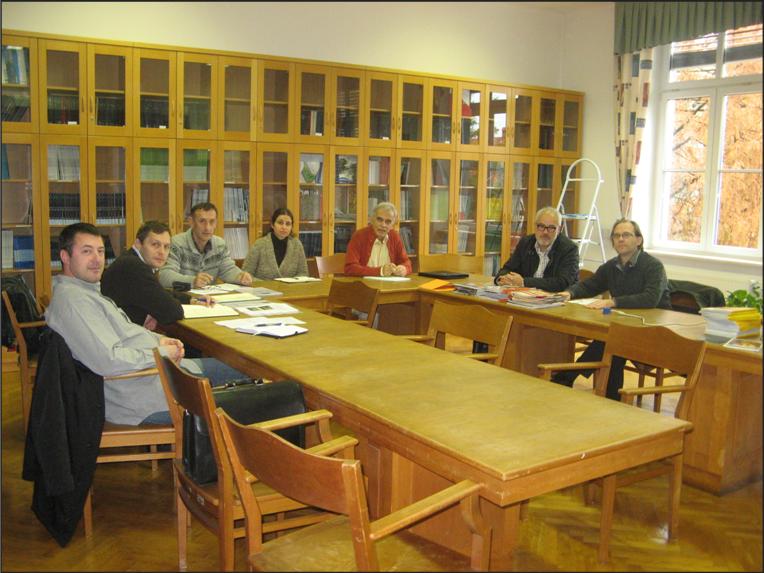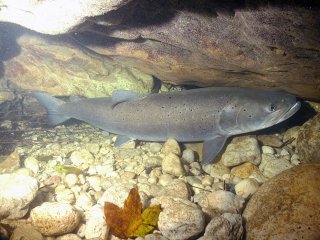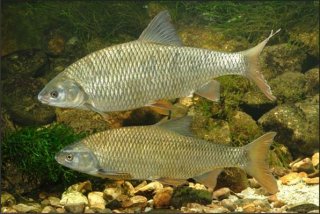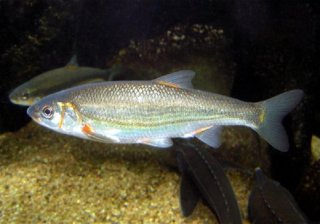Goals in actions
In 2012, a project was initiated to improve the
living conditions of endangered fish species in Ljubljanica. These
species are Danube Salmon (Hucho hucho),
Danube Roach (Rutilus pigus)
and Striped Chub (Leuciscus souffia). The improvement will be achieved
by removing the barriers to fish migration to the rehabilitation of
fishways. We will aim to improve the water regime and the restoration of
aquatic habitats. Furthermore, we will improve the water infrastructure
and establish hydrological monitoring to help improve water management.
We will restore functionality of the Ljubljanica corridor, connecting
two, now unrelated Natura 2000 areas.
On the Ljubljanica, the weir before the railway bridge
in Zalog will be sealed, preventing the lowering of water level in the
oxbows of Ljubljanica, which will improve the water conditions during
dry seasons. The fishways at the dam at the Fužine Castle and the sluice
gate at the Ambrose Square will be refurbished and renovated, thereby
enabling the migration of fish, which is now disabled. On the
Ljubljanica near the Ambrose Square the sluice gate will be renovated by
installing a gate valve control. As it is, the chain lock lifting
mechanism allows for a rough control of flows and water levels. The
upgrading or improvement of the barrier will allow for a more precise
regulation of water levels of the Ljubljanica, as well as a better
oxygen uptake, especially during low flow and during dry periods. It is
vital to maintain an appropriate level of the Ljubljanica, as it affects
the entire water regime of the Ljubljana Marshes. The water regime in
the Ljubljanica and its tributaries affects the habitats and species
included in the Natura 2000 network, but it also affects the activities
of fisheries, tourist navigation, drainage of sewerage system, sound
agriculture and, eventually, the entire infrastructure. During low water
levels of the Ljubljanica, land drainage and hence excessive subsidence
of soil occur, deteriorating the living conditions of endangered species
and the condition of the entire urban infrastructure of the Ljubljana
Marshes.
The project is primarily designed to improve fish
habitats, for which specific areas in the Natura 2000 network are
designated. In addition, in the project solutions to some other
aforementioned activities will be found indirectly.
An integral part of the project is the elaboration of
both a hydrological model and a hydraulic model. For the purpose of the
project, the models will be adjusted to low flow conditions; however,
they will also allow the analysis and operation of flood measures for
flood protection, navigation and other provisions on the Ljubljanica.
Funding
The project, with a total budget of €1.19 million, is financed by:
- European Commission under the LIFE+ Nature & Biodiversity 2010 (49.2%)
- Ministry of Agriculture and the Environment of the Republic of Slovenia (20%)
- Project Coordinator (19.7%): University of Ljubljana, Faculty of Civil and Geodetic Engineering (UL FGG)
- Partners (11.1%): Purgator d.o.o. and Geateh d.o.o.
Project Coordinator
University of Ljubljana,
|
 |
The Faculty of Civil and
Geodetic Engineering of the University of Ljubljana is an
institution with a tradition. Its study programs in civil engineering,
geodesy and water management and municipal engineering are recognized
internationally. The basic mission of the Faculty of Civil and Geodetic
Engineering UL is undergraduate and postgraduate education of personnel
in accordance with the needs of Slovenian construction, geodesy, water
management and municipal engineering. Due to the constant changes taking
place in our cultural and physical environments, the work of the faculty
also focuses on basic, applied and development research from the areas
of natural sciences and mathematical sciences, engineering,
environmental and social sciences. A special segment of its activities
is the transfer of knowledge into practice and professional consulting.
The areas of expertise covered by the Chair of
Hydrology and Hydraulic Engineering (KSH) are: hydrology, erosion and
sedimentation, water, land drainage, river engineering facilities, use
of water power, hydrology and management of natural risks.
As a science, hydrology is part of geophysics; hence, it is included
among natural sciences. It deals with the circulation of water in
nature; since water engineering facilities serve to regulate the water
regime and its exploitation, we must possess a good knowledge of the
quantity and quality of water. The tasks of engineering hydrology that
are the concern of KSH include the determination of water volume and its
quality, identification of the likelihood of their occurrence and impact
assessment of buildings and water use to the change of the water regime.
In the field of hydrology, KSH in recent years participated in several
European projects.
Water science deals with water policy. Given the
importance of water for the development and survival of the society,
water science is extremely wide ranging and, in addition to technical
skills, the basic knowledge of social sciences is required, i.e. in
sociology, law, economics and information technology. KSH has made good
progress in developing information bases in Slovenia by elaborating the
hydrographic coding system.
The area of water management, as an important part of
hydraulic engineering, is broad and ranges from the study of the
processes of erosion and sedimentation as natural bases of water
management, through regulatory methods and dimensioning of water
engineering structures, to management of natural hazards, as a
socio-economic component, where the participation of stakeholders is
important. In the field of urban water management – following intense
sediment transport studies in the 1990's and thus contributing to the
body of knowledge in the field of fluvial abrasion, and through the
development of a patented prototype meter for determination of the
dynamic forces on the movement of pebbles in turbulent flows –, KSH's
activities shifted into sustainable management of watercourses and the
methodology evaluating ecomorphological properties of water bodies.
The areas of water engineering structures and the
exploitation of water power deal with the basics of dam engineering and
power generation by hydropower plants. The consumption of electricity in
Slovenia is increasing with such an intensity that the production
capacity hardly meets the increasing demand. Hydropower is one of the
most important strategic energy resources in meeting the energy needs in
the future.
Today, KSH employs five teachers and one teaching
assistant, two young researchers and four full-time professional staff
members. In the past KSH offered part time employment to a number of
experts in various fields related to hydraulic engineering and
hydrology.
Partners
GEATEH d.o.o |
 |
The GEATEH d.o.o. is a company that is commercially
active in the fields of environmental protection, hydropower and urban
infrastructure, i.e. from planning to execution, while providing project
management services. Today the company employs nine staff members. The
key experts are engineers in civil engineering, chemical technology and
environmental protection. Due to the wide staffing structure, the
company is able to undertake complex consultancy tasks for clients from
the industry, local authorities, universities and state.
The Environmental Protection Group of GEATEH provides
services related to environmental protection at the operational and
strategic levels, the tasks arising from the requirements of applicable
environmental and other legislation, while adapting to the requirements
and needs of the clients.
Only recently has the company provided services related
to hydropower; however, the company human resources and technical
support are strong and experienced enough to be able to cope with the
most demanding projects. In collaboration with the largest Slovenian
companies, such as the HSE Group, and university centres in Slovenia,
they are focusing on the siting of hydropower facilities, and the
impacts on the environment and the public.
The principal activity of the Municipal Infrastructure
Group is to provide the clients and users with comprehensive solutions
in municipal collection and treatment of wastewater, drinking water
supply and care regarding implementation.
PURGATOR d.o.o. |
 |
The PURGATOR d.o.o. Company was founded in 2006. The
main activity of the company is implementation engineering of wastewater
treatment plants (design, construction and management, and other civil
engineering works).
The company employs several experts in the fields of
engineering, waste water and sewerage. Most of them have international
experience.
The PURGATOR d.o.o. also offers the following services:
- project management
- advice on the design of water treatment plants and pre-processing, design of sewerage systems, tender documents
- preparation of environmental impact assessments (EIA)
- making preliminary designs, detailed technical specifications, design documents, tender documents
- preparation of pre-feasibility and feasibility studies
- control over the construction of water treatment plants and sewage
- start-up of treatment plants
- creation of guidelines for the safe operation and maintenance
- making of operational logs
- staff training
Steering Commitee

Target species
Hucho hucho L. (Danube Salmon)
Conservation status:


Scientific classification:
- Kingdom: Animalia
- Phylum: Chordata
- Class: Actinopterygii
- Order: Salmoniformes
- Family: Salmonidae
- Subfamily: Salmoninae
- Genus: Hucho
- Species: H. hucho
Characteristics:
The Danube Salmon is the biggest salmonid species in Europe. It is
endemic to the Danube basin and inhabits montane and submontane reaches
of large streams and swift rivers with gravel beds, well oxygenated,
fast flowing water and water temperatures rarely more than 15 °C. It
prefers deep pools and shady water under overhanging vegetation. Its
body reaches a length of one and a half metre. It has an oblong shape
with a very long head and big jaws. Its back and hips are covered with
irregularly shaped black spots. This species lives more than 20 years.
Males start to reproduce when they reach the age of 3-4 years and weigh
1 kg, while females start at 4–5 years weighing 2–3 kg. Spawning occurs
every year in early spring, once the water reaches a temperature of 8–10
°C. Then, adults migrate upriver towards suitable spawning grounds in
the upper reaches of the tributaries. Males arrive at spawning sites
first. Both sexes excavate a pit about 1.2–3 m in diameter, 10–20 cm
deep, and defend a small territory in the spawning grounds against other
individuals. The spawning usually takes place at night. During the
spawning act, both sexes cover the eggs with substrate. Larvae usually
hatch after 25–40 days and stay in the gravel until the yolk sack is
absorbed, i.e. after 8–14 days. Juveniles are benthic and inhabit fast
flowing waters. Smaller fish feed on the larvae of water insects or on
insects dropped into the water, while larger individuals are predators
of other species of fish and other small terrestrial vertebrates. Both
juveniles and adults are territorial.
The decline of the species was historically caused by overfishing,
pollution and dam construction. Currently, the main threats are
hydropower plants which heavily regulate the flow regime (impact upon
their prey and habitat); the other cause of the decline is, in some
countries, pollution (Bosnia and Croatia).
Each year, fish clubs Barje and Vevče introduce 200 Danube
Salmons,
30–35 cm long, in the Ljubljanica River, fish club Vrhnika introduces
different numbers of Danube Salmon and of different length, while fish
club Dolomiti does not stock the Ljubljanica with Danube Salmon.
Rutilus pigus Heckel (Danube Roach)
Conservation status:


Scientific classification:
- Kingdom: Animalia
- Phylum: Chordata
- Class: Actinopterygii
- Order: Cypriniformes
- Family: Cyprinidae
- Genus: Rutilus
- Species: R. pigus
Characteristics:
The Danube Roach is endemic to the Danube basin. In Slovenia, it
inhabits the lower reaches of the Drava River, Sava River, Mura River,
Krka River, Ljubljanica River and their tributaries. We can find it in
streams with slow to moderate water flow and abundant aquatic
vegetation, with summer water temperatures between 20 °C and 23 °C. It
lives in small groups up to 10 years and grows up to 40 cm in length.
The adult body is laterally flat, the body of juveniles is more
spindle-shaped. All fins are red, while scales are big and dark
bordered. It is a lithophytophilic spawner, which spawns from March to
May in the tributaries on gravelly shoals or shallow reaches covered
with aquatic vegetation. It feeds on invertebrates, algae and detritus.
The population is endangered by river pollution, overfishing and river
regulations which result in a stronger river flow and destruction of
gravelly areas and spawning places. In the Red List of Fresh Water Fish
in Slovenia, it is assigned to the category of endangered (E) species.
Fish clubs Barje, Vevče and Dolomiti do not introduce the Danube Roach
in the Ljubljanica River; however, fish club Vrhnika stocks the
Ljubljanica with a different number of Danube Roach each year.
Leuciscus souffia Risso (Striped Chub)
Conservation status:


Scientific classification:
- Kingdom: Animalia
- Phylum: Chordata
- Class: Actinopterygii
- Order: Cypriniformes
- Family: Cyprinidae
- Genus: Leuciscus
- Species: L. souffia
Characteristics:
Striped Chub inhabits the Mediterranean catchment in the south France,
the upper Rhine River basin in Germany (extinct) and Switzerland, the
Soča River basin, the Danube River basin – the western tributaries in
Germany, Austria, Slovenia, Croatia and part of Bosnia and Herzegovina.
It is the smallest representative of genus Leuciscus in Slovenia, with a
body length up to 20 cm. Approximately in the middle of the hips it has
a wide, dark longitudinal stripe. It prefers the middle reaches of
streams and rivers with clear, moderately cold water, moderately swift
current and gravel bottom; however, it can be found in most habitats.
Striped chub is a gregarious fish species which spawns in March to May
in areas with swift, shallow water on gravel beds. Its food consists
mainly of aquatic invertebrates from the bottom and water surface, and
of epilithic algae. River regulations and water pollution represent a
danger for the species. In the Red List of Fresh Water Fish in Slovenia,
it is assigned to the category of endangered (E) species.
Fish clubs Barje, Vevče, Dolomiti and Vrhnika do not stock the
Ljubljanica River with Striped Chub.
At fish club Barje, the inventory of ichthyofauna in its region is not performed; however, in 2008 an inventory was held in the region of fish club Vevče. Among 172 caught fish there were 11 Danube Salmons, 18 Danube Roaches and one Striped Chub. According to an oral source, 10 striped chubs, 5–6 Danube Salmons and no Danube Roaches were caught among 200 caught fish in the space of 300 m in the region of fish club Dolomiti.


